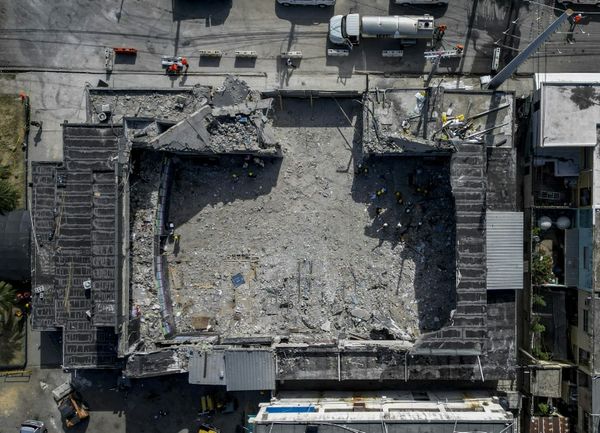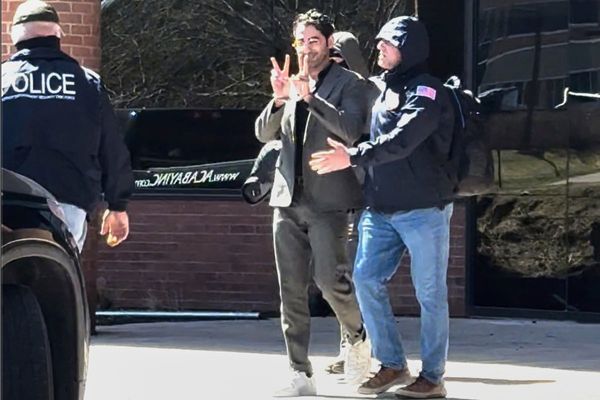SAN DIEGO — Two vans and a car pulled into the restricted access parking lot by El Chaparral Plaza on the Tijuana side of the San Ysidro Port of Entry a little before noon on Monday.
Parents and their children — 35 asylum seekers in all — got out and gathered their belongings. Many paused to hug or shake hands with the driver of the second van, a pastor who ran the shelter where many of them lived during their time in Tijuana. As they lined up, documents in hand, against the port of entry wall, one Guatemalan woman ran back to hug the pastor one last time.
They zigged and zagged their way up the walkway that would lead them to the place they had been trying to reach in some cases for over a year — U.S. soil — waving and beaming back at the group of advocates who had helped them get there.
As normal as it once was for asylum seekers to approach a U.S. port of entry on foot and be allowed to request protection, such a scene has become rare for any nationality besides the thousands of Ukrainians who were recently allowed into the United States.
Asylum processing at U.S. ports of entry has been largely closed for years due to a pandemic policy known as Title 42 that says border officials can keep out asylum seekers and other undocumented migrants and expel those who enter the United States without permission. The policy has been controversial from the beginning because it forces asylum seekers — who have a legal right in the United States to be screened to see if they qualify as refugees — to wait indefinitely in dangerous conditions. Human Rights First has documented more than 10,000 violent attacks in Mexico on asylum seekers affected by the program since the Biden administration took office.
But in recent weeks, scenes like Monday's have played out daily in the Chaparral parking lot because Customs and Border Protection has organized two pathways to identify vulnerable asylum seekers and exempt them from that pandemic rule on a case-by-case basis.
One of those pathways is coordinated through San Diego-based Border Angels, which collaborates with directors for more than a dozen migrant shelters as well as Tijuana-based nonprofits. The second is a process similar to one that existed last summer because of a lawsuit brought by the American Civil Liberties Union known as the Huisha-Huisha case.
Even with both processes, the numbers are small — just over 70 people entered from Tijuana on Tuesday — especially when compared with the hundreds of Ukrainians who were given exemptions to Title 42 daily at that same entry until recently.
Border Angels' executive director Dulce Garcia said she has received videos from families thanking her organization after they reach their loved ones in the United States.
"This is life saving for them," Garcia said. "They were very much at risk of losing their lives while they were waiting."
CBP did not respond to a request for comment in time for publication.
Last summer, ACLU lawyers negotiated a temporary settlement in the Huisha-Huisha case with the Biden administration in hopes that Title 42 would soon be lifted. Under the agreement, as long as CBP approved the individuals, attorneys were able to identify up to a certain number of cases per day with medical or other vulnerabilities to enter at ports of entry along the southwest border.
Garcia helped identify those cases last year. But those negotiated exemptions ended abruptly in August when it became clear that the Biden administration had decided to continue with Title 42 for the foreseeable future.
"Exemptions for vulnerable families are important but by no means are a substitute for ending Title 42, particularly since there are so few exemptions," said Lee Gelernt, the attorney with the ACLU leading the Huisha-Huisha case.
The Centers for Disease Control and Prevention, which is responsible for Title 42, recently announced that the policy would end on May 23 of this year. But that has now been challenged in court and temporarily blocked by a federal judge in Louisiana. The temporary restraining order allows for exemptions to Title 42 on a case-by-case basis provided that the numbers do not exceed historical levels.
The federal government, attorneys, advocates and asylum seekers alike are waiting to see what will happen after a May 13 hearing in the case.
In the meantime, Garcia was approached by CBP to organize with the Tijuana shelters, which Border Angels supports through monetary and other donations, to identify especially vulnerable asylum seekers staying in the shelters who should be exempted from Title 42 and transport them to the border for processing.
It began with just 10 people crossing per day, and that has grown to 35. At one point CBP asked Garcia to increase to 50, but she didn't have the resources to make that happen right away. Officials have since told her that the capacity for her process will remain at 35, she said, which is supposed to run through May 23 and perhaps longer depending on what happens in the next few weeks.
Every day, Border Angels identifies 35 names from a list of asylum-seeking families that Garcia made with help and input from shelter directors. The list prioritizes those with medical conditions, including pregnant women, asylum seekers who are part of the LGBTQ community and those who have been living in the shelters for more than a year.
Having to make those choices has been hard on Garcia.
"That's the most heartbreaking part of the job," she said. "Everyone is vulnerable. Everyone in these shelters are without security of food, without security of housing. They are all fleeing from something horrible. The first few days were hardest because we had no assurances how many days we would have and we were told 10 people. So from 2,200 that we have in these spaces, we had to pick 10 people that would be among the first ones to cross. That was devastating. I wanted to include everyone on that list."
Once the names are selected, the information is sent to CBP for approval, and then the asylum seekers are notified. They have less than 24 hours to pack and say goodbye to the friends they've made in their temporary homes.
On Monday, Eduardo Lizarraga of Psicólogos Sin Fronteras, an organization partnering with Border Angels on the project, drove a large van he nicknamed El Monstro up a rocky dirt road to Embajadores de Jesus, a church-turned-migrant-shelter tucked away in one of Tijuana's canyons. Most of the people who would enter on Monday were staying at that shelter.
Inside, the air buzzed with hugs, heart-felt goodbyes and hope — a feeling that had been absent from the shelter for some time.
The asylum-seeking families staying there celebrated those who had been selected to cross the border as well as the promise those crossings held for the rest waiting for the chance to seek protection. According to several women in the shelter, many of the families had been expelled after the Biden administration flew them from Texas to San Diego last year.
Many of the families had given away most of their belongings at the shelter, either to friends or in donation piles waiting for whomever arrives at the shelter next.
One Honduran man acknowledged the mixed feelings his family had about leaving the shelter — the gratitude for the opportunity to continue their journey and seek asylum, contrasting with the sadness at leaving behind friends, the pastor and the peace they had come to know in their time there.
Families from Honduras, Guatemala and Haiti loaded into El Monstro.
"It feels like a dream," one Honduran woman holding her two year old in her lap said in Spanish. She, like the other asylum seekers in this article, is not being fully identified because of her ongoing vulnerabilities.
The pastor, driving a second van full of families, followed behind.
The wait had been difficult, a Guatemalan woman said, describing being expelled by Border Patrol and being separated from her sister for weeks. But now, all she felt was grateful.
"God had a plan for us," she said.
The vans rendezvoused with cars from other shelters at a building that Border Angels has rented as a staging area. Gina Garibo of American Friends Service Committee provided a legal orientation to the group.
"We aren't able to represent you," she told them in Spanish. "We're helping you enter, and once inside, you will have to fight your case for asylum."
She explained the basic requirements for asylum — to qualify and be recognized as refugees, people have to show with evidence that they have been or are likely to be persecuted because of their race, religion, nationality, political opinion or membership in a social group such as the LGBTQ community. They also have to show that persecution was by their government or a group that the government cannot or will not control.
Most of the adults in the group listened intently. A few chased after their young children who were trying to explore the space.
Then they got back into the vans and drove to the port of entry.
As of Tuesday afternoon, according to Garcia, Border Angels and its partners have helped more than 300 people enter there. They were all given dates to appear in immigration court before they were let into the United States, Garcia said.
She said that given the fixed amount of 35 people, those who will be crossing between now and May 23 have already been identified. She emphasized that migrants who show up at the shelters now will not be able to get on the list. She worried that as rumors spread in Tijuana among asylum seekers about the new processes that many will go to shelters out of desperation to get in. Some have already shown up.
The second process is not limited to people living in Tijuana's shelters, but also already has a queue of people for the coming weeks to enter with humanitarian parole.
Before 6 a.m. on Tuesday morning, a Salvadoran woman, her husband and their three children waited with their luggage among a group of asylum seekers in the parking lot of a Tijuana immigration office nearly seven miles from the border.
They'd been waiting to enter the United States for three years, the woman said, and on Tuesday, their turn had finally come. Her sister-in-law had already gone in through the process, she said.
"We've lived through so many things," the woman said. "It's one thing to hear about it, but it's another to see it."
A Mexican immigration official with a clipboard of 50 names circled among the asylum seekers, verifying who was present. Roughly a dozen were missing.
The rest boarded vans often used to transport people in Mexican immigration custody and made their way to the border. By 7 a.m., they were all inside.
____







